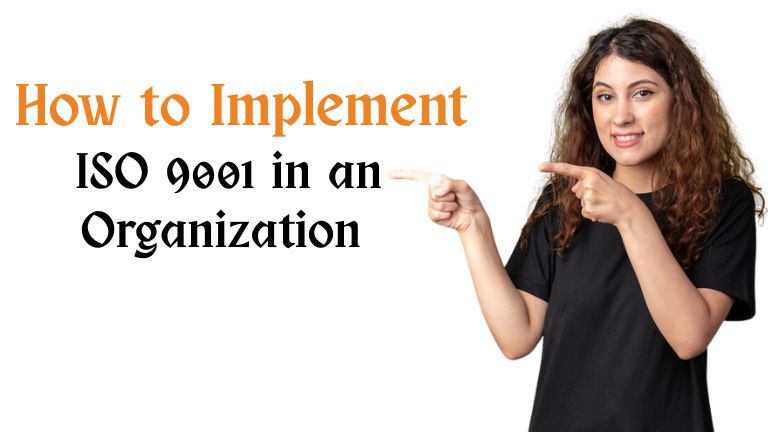Implementing ISO 9001 in an organization is a
strategic decision that can significantly improve efficiency, customer
satisfaction, and overall quality management. ISO 9001 is the internationally
recognized standard for Quality Management Systems (QMS), and it is applicable
to any organization, regardless of size or industry.
This guide outlines the essential steps to
implement ISO 9001 effectively and achieve certification.
Understand the Basics of ISO
9001
It's crucial to become acquainted with the structure and fundamental ideas of the standard before starting the implementation process. Seven quality management principles form the foundation of ISO 9001:
- Focus on the customer
- Participation of individuals in leadership
- Method of process
- Enhancement
- Improvement
- Evidence-based decision making
- Management of relationships
The standard follows a High-Level Structure (Annex
SL), making it easier to integrate with other ISO standards such as ISO 14001
(environmental management) or ISO 45001 (occupational health and safety).
Secure Top Management
Commitment
Successful ISO 9001 implementation begins with
leadership. Top management must fully understand the benefits and requirements
of ISO 9001 and actively support the process. Their involvement is crucial in:
- Aligning the QMS with the organization’s strategic direction
- Allocating necessary resources
- Encouraging a culture of continuous improvement
- Leading communication efforts
Management should appoint a responsible individual
or team, often referred to as the Quality Management Representative (QMR), to
oversee the implementation process.
Conduct a Gap Analysis
A gap analysis assesses your current management
system against the ISO 9001:2015 requirements. This step identifies:
- Areas of non-compliance
- Existing practices that meet the requirements
- Opportunities for improvement
A gap analysis provides a baseline and helps in
developing a realistic implementation plan. It can be conducted internally or
with the help of a consultant.
Develop an Implementation Plan
Using the findings from the gap analysis, create a
project plan that includes:
- Scope of the QMS
- Key objectives and targets
- Responsibilities and resources
- Timelines and milestones
- Training needs
This plan should be practical, with clearly defined
tasks and deadlines to ensure progress is tracked.
Define the Scope and Document
Processes
Define the boundaries of your Quality Management
System—what products, services, departments, and locations are included.
Then, identify and document the core business
processes. This involves:
- Mapping process flows
- Defining inputs and outputs
- Assigning responsibilities
- Establishing performance indicators
Documentation may include a quality manual, quality
policy, procedures, work instructions, and records. However, ISO 9001:2015
emphasizes performance over documentation, so only maintain documents that add
value.
Provide Training and Awareness
Educating employees at all levels about ISO 9001 is
vital. Training should include:
- General awareness of ISO 9001
- Roles and responsibilities under the QMS
- Internal auditing (for selected employees)
- Specific process and procedure training
Employee involvement is key to successful
implementation. Make sure staff understands how their work affects quality and
customer satisfaction.
Implement the QMS
Now it's time to put your plans into action.
Implement the new or updated procedures, monitor performance, and collect
records as evidence of compliance.
Key areas to focus on include:
- Control of documents and records
- Operational controls
- Risk-based thinking and preventive actions
- Customer feedback and satisfaction
- Performance monitoring and measurement
You may face challenges like resistance to change
or operational disruptions. Communicate clearly and address concerns
proactively.
Conduct Internal Audits
Internal audits are a mandatory requirement of ISO
9001 and help ensure the QMS is functioning effectively. Internal auditors
should be trained and ideally independent of the areas they audit.
Audits should cover:
- Conformity to ISO 9001 requirements
- Effectiveness of the processes
- Opportunities for improvement
Findings should be documented, and corrective
actions must be taken for any non-conformities identified.
Conduct a Management Review
Top management must review the QMS regularly to
ensure its continuing suitability and effectiveness. The management review
should evaluate:
- Audit results
- Customer feedback
- Process performance and objectives
- Non-conformities and corrective actions
- Resource needs
- Opportunities for improvement
Management reviews help reinforce leadership
commitment and promote strategic alignment.
Engage a Certification Body
Once the QMS is fully implemented and matured
(typically after at least 3 months of operation), you can apply for
certification through an accredited certification body.
The certification process includes:
- Stage 1 Audit – Review of documentation
and readiness
- Stage 2 Audit – Evaluation of actual
implementation and effectiveness
If the audits are successful, the organization will
be issued an ISO 9001 certificate, usually valid for three years, with annual
surveillance audits.
Promote Continuous
Improvement
ISO 9001 is not a one-time effort. It’s a
continuous journey. Post-certification, maintain the QMS by:
- Monitoring performance indicators
- Reviewing processes periodically
- Seeking customer feedback
- Conducting regular audits
- Updating documentation as needed
- Encouraging a culture of quality
Continual improvement helps sustain compliance, reduce
costs, enhance productivity, and retain customer trust.
Conclusion
Implementing ISO 9001 may seem like a daunting
task, but with proper planning, commitment, and involvement from all levels of
the organization, it becomes a valuable investment. Beyond just achieving
certification, ISO 9001 helps build a quality-first culture that delivers
long-term business benefits.
Whether you’re a startup or a large enterprise, ISO
9001 can serve as a framework for excellence—driving performance, enhancing reputation,
and ensuring consistent delivery of quality products and services.

